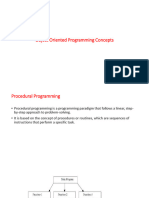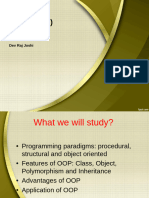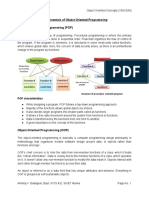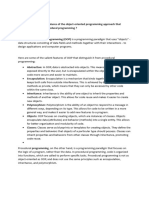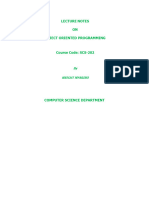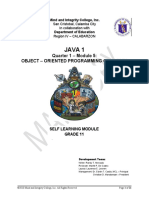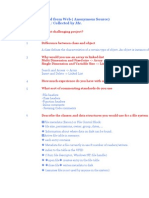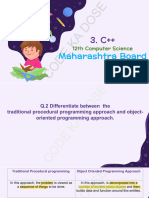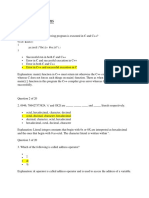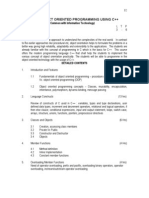UNIT-5_-Object-Oriented-Programming
Uploaded by
bimochandhungel57UNIT-5_-Object-Oriented-Programming
Uploaded by
bimochandhungel57UNIT 5: Object Oriented Programming
Programming Paradigm
Definition:
A programming paradigm is a set of rules or methods that guide how programmers write
and organize code. It determines the approach to problem-solving and program
structure. The main paradigms include procedural, structural, and object-oriented
programming. Each paradigm has its own characteristics and is suited to specific kinds
of problems.
1. Procedural Programming Paradigm
● Definition:
Procedural programming focuses on breaking down a task into a sequence of
procedures or routines (also called functions). It follows a step-by-step
approach to solve a problem.
● Features:
○ Uses functions to perform specific tasks.
○ Data and procedures are separate, and data is passed between
procedures.
○ Follows a top-down design approach.
○ Relies heavily on global and local variables.
● Advantages:
○ Simple and easy to understand.
○ Effective for small and simple programs.
○ Code reuse through functions.
● Disadvantages:
○ Limited scalability for large applications.
○ Data is not well-secured, as global variables are accessible everywhere.
● Examples of Procedural Languages:
C, Pascal, Fortran.
2. Structural Programming Paradigm
● Definition:
Structural programming is an extension of procedural programming that
emphasizes the use of structured control flow (e.g., loops, conditionals) and
eliminates the use of goto statements for better readability and maintainability.
● Features:
○ Program flow is controlled by loops, conditionals, and functions.
○ Focuses on a modular design with reusable code blocks.
○ Avoids unstructured jumps (e.g., goto statements).
● Advantages:
○ Easier to debug and maintain due to structured flow.
○ Improved readability and organization.
○ Promotes modularity.
● Disadvantages:
○ Still lacks the security and real-world modeling capabilities of OOP.
○ Can become complex for very large systems.
● Examples of Structural Languages:
C, C++, Python (in procedural style).
3. Object-Oriented Programming (OOP)
Definition:
A programming paradigm where real-world entities are represented as objects,
grouped into classes, and controlled by superclasses. It emphasizes data security and
reusability by encapsulating data and functions within objects.
Features of OOP (Object-Oriented Programming)
1. Class
● A class is a user-defined data type in OOP, which serves as a blueprint for
creating objects.
● It defines the attributes (characteristics) and behaviors (functions) shared by all
objects of that class.
● Example: A class Vehicle can define attributes like color and speed and
behaviors like start() and stop(). Objects like car, bus, and truck can be
created from this class.
2. Object
● Objects are instances of a class that represent real-world entities.
● Each object has:
○ Attributes: Characteristics that describe the object (e.g., color, size,
weight).
○ Behaviors: Functions or actions it can perform (e.g., move, turn).
● Example:
○ A car object from the Vehicle class can have attributes like color:
red and behaviors like move().
3. Abstraction
● hides the complex internal details of an object and provides only the
Abstraction
essential information to the user.
● Users interact with a simplified interface without needing to understand how it
works internally.
● Example:
○ A car's steering wheel lets the driver control the direction without knowing
how the steering mechanism works.
4. Encapsulation
● Combines data (attributes) and functions (behaviors) into a single unit (class).
● Protects the internal state of an object by restricting access to its data through
public methods.
● Prevents unrelated functions from accessing or modifying private data.
● Example:
○ In a BankAccount class, attributes like balance are private, and
functions like deposit() and withdraw() control access to the
balance.
5. Inheritance
● Inheritance allows a child class (subclass) to inherit attributes and behaviors
from a parent class (superclass).
● Promotes code reuse, reduces redundancy, and supports hierarchical
relationships.
● Example:
○ A class Animal has attributes name and species and a behavior
eat().
○ A Dog class inherits these attributes and behaviors and adds a new
behavior bark().
6. Polymorphism
● Polymorphism means "many forms."
● It allows the same operation or method to behave differently based on the
context.
● Examples:
○ Operator Overloading: The + operator can perform arithmetic addition (3
+ 2 = 5) and string concatenation ("Hello" + "World" =
"HelloWorld").
○ Method Overloading: A function draw() can behave differently for
Circle, Square, or Triangle objects.
Enhanced Summary Table of OOP Features
Feature Description Example
Class Blueprint for creating objects; class Vehicle { color,
defines shared attributes and speed; start(),
behaviors.
stop(); }
Object Instance of a class with specific A car object with color: red
attributes and behaviors. and behavior move().
Abstraction Hides complex details, showing A car's steering wheel lets you
only essential functionality. steer without knowing the
internal mechanism.
Encapsulati Combines data and methods; class BankAccount
on protects internal data using private { private: balance;
attributes and public methods.
public: deposit(),
withdraw(); }
Inheritance Allows child classes to inherit class Dog extends Animal
properties and methods from { bark(); }
parent classes.
Polymorphis Enables the same operation to Operator + used for both 3 + 2
m perform differently based on the and "Hello" + "World".
context.
Difference Between POP (Procedure-Oriented Programming) and OOP
(Object-Oriented Programming)
Aspect Procedure-Oriented Object-Oriented Programming
Programming (POP) (OOP)
Approach Focuses on functions or Focuses on objects that
procedures. encapsulate data and behaviors.
Program Programs are divided into Programs are divided into
Structure smaller procedures or classes and objects.
functions.
Data Handling Data is treated as global and Data is encapsulated within
can be accessed by all objects, restricting unauthorized
functions. access.
Data Security Less secure due to high More secure due to data hiding
possibility of data alteration. and controlled access
mechanisms.
Code Limited reusability as functions High reusability through
Reusability are independent and not tied inheritance and polymorphism.
to data.
Execution Flow Follows a top-down approach. Follows a bottom-up approach.
Complexity Difficult to manage as program Easier to manage due to
Management size increases. modularity and abstraction.
Examples of Functions, global and local Classes, objects, inheritance,
Concepts variables. polymorphism, abstraction, and
encapsulation.
Code Harder to maintain due to Easier to maintain due to the
Maintenance scattered code and lack of modular structure and
modularity. encapsulation.
Flexibility Less flexible; making changes More flexible; changes in one
requires altering multiple class can propagate through
functions. inheritance.
Real-World Does not model real-world Models real-world entities
Mapping entities directly. effectively using objects.
Key Examples C, Pascal, Fortran. C++, Java, Python, C#.
Advantages of OOP:
1. Solves complex problems step by step for easier handling.
2. Enhances software quality and reduces maintenance costs.
3. Easily scales from small to large systems without major changes.
4. Secures programs with data hiding to prevent unauthorized access.
5. Reduces redundancy and extends code usability through inheritance.
Disadvantages of OOP:
1. Complexity for beginners.
2. Increased memory and processing overhead.
3. Steeper learning curve.
4. Potential for overdesign.
5. Difficulty in debugging.
6. Performance overhead.
7. Not suitable for all applications.
Applications of OOP:
1. Software Development
2. Graphical User Interface (GUI) Development
3. Database Systems
4. Simulation and Modeling
5. Embedded Systems
6. Artificial Intelligence (AI) and Machine Learning
7. Financial Systems
8. Robotics
Applications of OOP (Object-Oriented Programming)
Object-Oriented Programming (OOP) is widely used in various domains because of its
modular and reusable nature. Below is an explanation of the applications
1. Software Development
OOP is the backbone of modern software development. It provides modularity and
reusability, enabling developers to build scalable and maintainable applications.
● Example: Enterprise applications like Microsoft Office or Google Workspace
use OOP principles for managing complex functionalities.
● Benefit: Code reuse through inheritance and modular code structure.
2. Graphical User Interface (GUI) Development
GUIs are often designed using OOP because of their interactive nature and need for
event-driven programming.
● Example: Java Swing, JavaFX, and Tkinter for GUI design in desktop
applications.
● Benefit: Each component of the GUI (buttons, text fields, sliders) can be
represented as an object, making it easier to manage their behavior and
appearance.
3. Database Systems
OOP is extensively used in developing relational and object-oriented database systems.
● Example: Object-relational mapping tools like Hibernate in Java.
● Benefit: Entities like tables, rows, and columns in a database can be represented
as objects, providing a natural mapping between real-world entities and the
database structure.
4. Simulation and Modeling
Simulating real-world systems is a key area where OOP excels. It allows for the
modeling of complex entities with attributes and behaviors.
● Example: Flight simulation, traffic management systems, and weather
forecasting.
● Benefit: Classes and objects can represent real-world entities, making
simulations realistic and dynamic.
5. Embedded Systems
OOP is used in developing software for embedded systems, where software interacts
directly with hardware.
● Example: Software for washing machines, medical devices, or automotive control
systems.
● Benefit: Modular design allows for better code organization and easier updates.
6. Artificial Intelligence (AI) and Machine Learning
OOP is used in developing AI and machine learning systems because of its ability to
handle large datasets and modularize complex algorithms.
● Example: Libraries like TensorFlow and PyTorch use OOP principles.
● Benefit: Machine learning models and datasets can be represented as objects,
making the code reusable and extensible.
7. Financial Systems
OOP is used in banking and financial systems to manage transactions, accounts, and
customer data.
● Example: Stock trading systems, payment gateways, and banking
applications.
● Benefit: It ensures the security of sensitive data and helps in building robust
systems that can handle millions of transactions.
8. Robotics
OOP is crucial in robotics programming, where robots are modeled as objects with
various components and behaviors.
● Example: Robots developed using frameworks like ROS (Robot Operating
System).
● Benefit: Sensors, motors, and control algorithms can be modularly designed,
improving the development and testing process.
Why OOP is Preferred:
● Reusability: Code written once can be reused in multiple places (inheritance).
● Modularity: Breaking down a system into smaller objects makes it easier to
debug and maintain.
● Abstraction and Encapsulation: Complex details can be hidden, and data
security is enhanced.
● Scalability: Easy to extend the system by adding new classes and features.
OOP has revolutionized the way software is developed and maintained, making it the
most popular paradigm for building reliable and scalable systems.
You might also like
- Introduction Object-Oriented ProgrammingNo ratings yetIntroduction Object-Oriented Programming67 pages
- Chapter 10 Recent Trends in ProgrammingggNo ratings yetChapter 10 Recent Trends in Programminggg12 pages
- Unit-1 (Part-A) Notes of OOPS by Updesh Kumar - UpdatedNo ratings yetUnit-1 (Part-A) Notes of OOPS by Updesh Kumar - Updated29 pages
- 1.1 Procedure Oriented Programming: Main ProgramNo ratings yet1.1 Procedure Oriented Programming: Main Program9 pages
- Object Oriented Programming & C++-Assignment-No ratings yetObject Oriented Programming & C++-Assignment-16 pages
- Fundamentals of Object Oriented Programming Procedure Oriented Programming (POP)No ratings yetFundamentals of Object Oriented Programming Procedure Oriented Programming (POP)8 pages
- Usman Akhtar ROLL# 07-17 CELL NO 0313-6085383: Procedural ProgrammingNo ratings yetUsman Akhtar ROLL# 07-17 CELL NO 0313-6085383: Procedural Programming44 pages
- Lexicon of Programming Terminology: Lexicon of Tech and Business, #17From EverandLexicon of Programming Terminology: Lexicon of Tech and Business, #175/5 (1)
- What Is Object-Oriented Programming - OOP Explained in Depth100% (1)What Is Object-Oriented Programming - OOP Explained in Depth23 pages
- Java 1: Quarter 1 - Module 5: Object - Oriented Programming ConceptsNo ratings yetJava 1: Quarter 1 - Module 5: Object - Oriented Programming Concepts21 pages
- Core Java Oops Concepts Inheritance, Abstraction, Encapsulation, Polymorphism PPT PDF - Java Faqs Material PDF DownloadsNo ratings yetCore Java Oops Concepts Inheritance, Abstraction, Encapsulation, Polymorphism PPT PDF - Java Faqs Material PDF Downloads3 pages
- Unit 2: Classes, Inheritance, Packages & InterfacesNo ratings yetUnit 2: Classes, Inheritance, Packages & Interfaces156 pages
- Chapter 5 - Object-Oriented Database ModelNo ratings yetChapter 5 - Object-Oriented Database Model9 pages
- 200 C# Interview Questions_250119_123011No ratings yet200 C# Interview Questions_250119_12301130 pages
- Unit-1 (Part-A) Notes of OOPS by Updesh Kumar - UpdatedUnit-1 (Part-A) Notes of OOPS by Updesh Kumar - Updated
- Fundamentals of Object Oriented Programming Procedure Oriented Programming (POP)Fundamentals of Object Oriented Programming Procedure Oriented Programming (POP)
- Usman Akhtar ROLL# 07-17 CELL NO 0313-6085383: Procedural ProgrammingUsman Akhtar ROLL# 07-17 CELL NO 0313-6085383: Procedural Programming
- Lexicon of Programming Terminology: Lexicon of Tech and Business, #17From EverandLexicon of Programming Terminology: Lexicon of Tech and Business, #17
- What Is Object-Oriented Programming - OOP Explained in DepthWhat Is Object-Oriented Programming - OOP Explained in Depth
- Java 1: Quarter 1 - Module 5: Object - Oriented Programming ConceptsJava 1: Quarter 1 - Module 5: Object - Oriented Programming Concepts
- Core Java Oops Concepts Inheritance, Abstraction, Encapsulation, Polymorphism PPT PDF - Java Faqs Material PDF DownloadsCore Java Oops Concepts Inheritance, Abstraction, Encapsulation, Polymorphism PPT PDF - Java Faqs Material PDF Downloads
- Unit 2: Classes, Inheritance, Packages & InterfacesUnit 2: Classes, Inheritance, Packages & Interfaces





